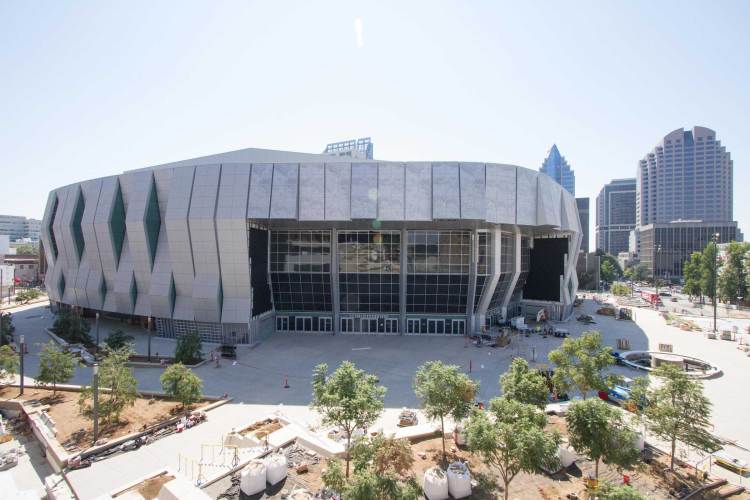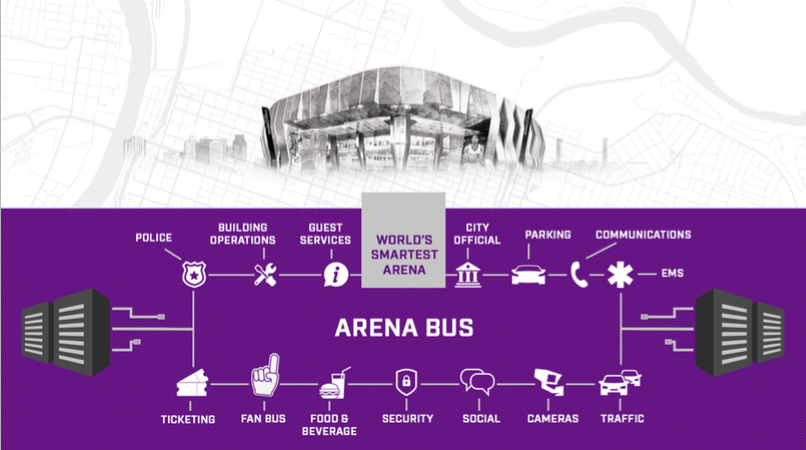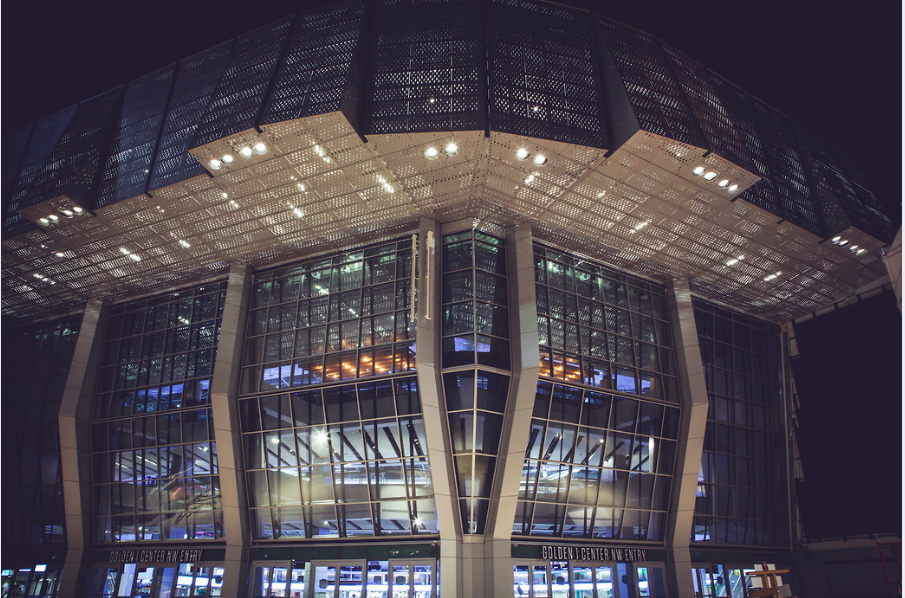Watching sporting events isn’t what it used to be. Teams have to find innovative and technologically savvy ways to attract fans and keep them captivated. “It’s about how you enhance the experience,” Kenny Lauer, vice president of digital and marketing for the NBA’s Golden State Warriors, once told VentureBeat.
To the Sacramento Kings, the experience is more than just getting people into the seats, it’s also about forming a relationship with the surrounding community. The basketball team has faced quite a conundrum in the past few years. In 2013, former Microsoft chief executive Steve Ballmer led a group of investors in offering $500 million to buy the Kings and relocate the team to Seattle.
Faced with the prospect of losing a major symbol of the city, Sacramento banded together to partner with a group — organized by businessman Vivek Ranadivé — to purchase the Kings for $348 million. However, a caveat of ownership was that Ranadivé had to find and build a new home for the team by 2017. This presented the Kings with a challenge and an opportunity: How would they not only develop a new arena, but make it one that brought a new experience to fans and deepened ties with the city’s business and residential communities?
The Kings’ new home will open in October with legendary artist Paul McCartney performing sold-out shows, and the team will officially play its first regular season game on October 27 against the San Antonio Spurs.
Civilization 3.0
For Ranadivé, formerly a minority owner of the Warriors, the new Kings home — called the Golden 1 Center — is more than a sports complex. It’s the centerpiece of what he calls “civilization 3.0,” which refers to cities where people can both work and reside. Currently, downtown Sacramento is a commuter town, one that typically clears out at the close of business. But with the Kings relocating to the heart of the city, Ranadivé hopes that California’s capital city will see renewed life.
The Golden 1 Center is a “21st century communal fireplace” for the city’s new chapter, according to Ranadivé. “It’s the things that you do around the fireplace, [that] will be what people figure out,” he said. The Kings “will provide the fire.” The group has invested $1 billion into building something that they believe isn’t just a place to watch sports; it’s a gathering place for the community. Kings president Chris Granger explained that an additional $500 million has been put into building restaurants, stores, and a 16-story hotel adjacent to the arena.
“We wanted this to be the first arena of the 21st century,” Ranadivé told us. “We wanted to flip the notion of what an arena is…you shouldn’t check into the arena, the arena should check into you.”
That may sound far-fetched, but the point he’s trying to make is that the sports arena concept hasn’t been updated for decades. But the Sacramento Kings were able to start from scratch and incorporate the technology necessary to achieve Ranadivé’s vision.
A key element of the master plan is a mobile app that lets fans personalize their experience — and other sports teams have implemented similar technology. But here, it’s more than just letting fans order food from their seats or watch game highlights — the Kings’ app serves as a “remote control” for the whole arena. Fans can request an Uber to give them a ride to and from the stadium, reserve parking in a nearby lot, get real-time information about concession stand lines, and more. The app also provides data back to the Kings, so that they can proactively provide customer service and support — as chief technology officer Ryan Montoya described it, if a fan tweets about dropping a hot dog, they will see that and will swoop in with a replacement.
The Kings’ mobile app will provide fans with real-time updates about what’s going on during a game, and it also gives fans the ability to manage their tickets within the app. Both Granger and Montoya shared the desire to move away from a paper system and believe that going completely digital will create more opportunities to customize a fan’s experience.
One thing that’s unique to the app is the inclusion of Kings Artificial Intelligence, or KAI, for short. This messaging bot is powered by JiffyBots and answers fan questions about the team and what’s going on during the game and also about the Golden 1 Center, itself.
The app is just one of the signals that the Kings will use to achieve Ranadivé’s vision for the arena. Inside the structure rests a 6,000-square-foot data and command center that displays not only social media stats, but also weather conditions, police and traffic updates, and other pertinent information.
It’s here at “mission control” that the Kings and arena staff get to know all about fans who have opted-in to receive a personalized experience. Montoya shared that within moments, staff can see that you’ve passed through one of the building’s “smart turnstiles” and see what you’ve ordered, where you’re sitting, and where you are at any moment. In fact, the technology will be able to read tickets from smartphones, smart watches, and tablets — yes, the Kings said that tablets are popular at games. One benefit of this technology is that turnstiles should be able to admit fans more quickly, churning through 1,000 fans an hour.
With this data-driven infrastructure, the Kings could also see that you’ve been at the past three home games and posit that you might be a season ticket holder. Then an attendant, armed with an iPad Pro, could track you down and offer white glove service — perhaps even an upgraded seat?
The command center is also the place where the Kings liaise with local police, fire, and transportation officials in order to provide a safe and secure experience. There’s also a room for video, where the Kings can control the hundreds of monitors stationed throughout the arena, and there’s even a small studio where quick interviews and clips can be assembled and posted online in an expedited fashion.
The “bus” that keeps things going
The mobile app and command center are just part of what the Kings call their “arena bus,” a system designed to combine the intelligence of everything that’s involved in the event. From police to building operations, guest services, traffic and parking, communications and social, food and beverage, fan buses, and tickets, the data is integrated to provide what Ranadivé hopes will be a “seamless, frictionless experience.”
Ranadivé had in mind a platform that would future-proof the arena and enable additional third-party integrations, when needed. Over time, the Kings will be opening up an API that allows developers to contribute to the fan experience. Ranadivé said the Kings won’t be too strict in limiting what apps use its API, as they see themselves a simply providing a platform.
The Golden 1 Center in the heart of downtown Sacramento is hard to miss, as it encompasses three acres (approximately six city blocks), but care has been taken to integrate it into its surroundings. Granger said that the Kings dug 39 feet below the surface so that when you walk into the arena, you’re looking down to the court.
To implement Ranadivé’s goal of turning the arena into a “communal fireplace,” courtyards and public spaces were built around the Golden 1 Center, offering people a nice place to sit and have a meal during the day. The main entrance of the arena consists of several large airport hangar doors that can open to provide those outside with a better view of what’s happening inside. This is what makes the Kings’ new home the first indoor/outdoor arena.
Technologically speaking, the arena is perhaps the most advanced in the world. Most probably know that it has the first 4K ultra high-definition scoreboard in the NBA, covering 6,100 square feet, with 38 million pixels. Hanging over the court, the four screens will display pertinent information about the game and be tilted in such a way that the teams courtside need only angle their heads slightly to get a clear view.
Golden 1 also houses more than 1,000 internet access points, one for every 17 guests — there are 800 access points in the arena bowl alone. The building is wired with over 1,000 miles of cable and has a 200 gigabit per second ethernet connection. To put that speed into context, more than 500,000 Snapchat posts can be processed each second. The Kings have wired Category 6A copper wire throughout Golden 1 to enable high-speed data transmission.
“This infrastructure will ensure that all fans experience the fastest speeds available – no more Facebook, Instagram, and Twitter posts that don’t send or real-time statistics that don’t load,” the Kings promised.
There are more than 1 million square feet of Wi-Fi and cell coverage in Golden 1, powered by Ruckus Wireless.
The building has received LEED platinum certification because it uses 100 percent sustainable energy, reduces its water consumption, and sources food for its concession stands locally. The Kings have partnered with California Safe Soil, a firm that won the Kings’ startup contest Capitalize earlier this year. California Safe Soil provides a full-cycle process that recycles the stadium’s food, converting it into liquid fertilizer product, and puts it back into the soil to grow more food. Golden 1 Center also has solar panels on its roof.
Its data centers have also been designed around maximum output, using the least amount of energy possible. As you walk into the central area, there are two columns of approximately 10 sets of data modules. Because of the Kings’ goal of future-proofing the arena, Montoya explained that not all the racks are filled, leaving enough space for more servers in future, if needed. The equipment in the room absorbs all the signals from the various smart sensors positioned throughout the arena, along with data from the mobile app and other sources, basically acting as the central nervous system for the building. What’s unique about the data center is that each server module contains a sealed door that keeps each set of servers temperature-controlled, eliminating the need to freeze the entire room.
The Kings are using enterprise point-of-sale (POS) and inventory system provider Appetize at concession stands, which enables fans to pay for their food using not only bitcoin, but also Apple, Android, and Samsung Pay through the system’s NFC terminals.
“If you think of it as just being a sports team, it has limited value,” Ranadivé commented. “But if you think of it as a social network and leverage the technology, the value is 5 to 10 times greater.” He believes the Kings are ahead of the curve when it comes to sports leagues adopting technology, but he says other teams “have a very open mind.”
“When I became an entrepreneur 25 to 30 years ago, banks were the early adopters of technology. Now it’s going to be sports leagues and arenas,” he claimed. And while the San Francisco Giants’ AT&T ballpark and the San Francisco 49er’s Levi’s Stadium have been heralded as high-tech, Ranadivé believes those are still based on a 20th century model.
“Mr. Real Time”

Above: Vivek Ranadive, serial entrepreneur and owner of the NBA’s Sacramento Kings
Ranadivé is certainly no stranger to the world of sports and technology. Before purchasing the Kings, he was a minority owner of the Golden State Warriors and had a hand in the digital transformation of the San Francisco Bay Area team. Prior to that, he founded the real-time computing companies TIBCO. He also founded Teknekron Software Systems and is credited with using it to modernize Wall Street in the 1980s.
Ranadivé has always been focused on bringing real-time technology into play. With Teknekron Software Systems, he worked with Goldman Sachs to provide real-time international transactions right from the trading floors. Then, at TIBCO, he brought real-time software applications to business in other industries, including CBS Sportsline, so the outlet could provide real-time news about the major sports leagues.
While the Warriors may have gotten more attention than the Kings, Ranadivé is adamant that his team should be considered more technologically advanced. He explained that Sacramento was the first to explore the application of virtual reality — some of the Kings’ games will be broadcast in VR this season, and fans in attendance will be able to watch VR replays from any seat. It was also the first team to accept bitcoin, use social media, use robots and drones, experiment with Google Glass, and deploy beacons.
But having the most connected building in the NBA wasn’t enough for Ranadivé, and he wanted this arena to meet four goals: It had to be iconic, something that you’d feature on a postcard; it also had to be “ecologically on magnitude” — he said the Golden 1 Center was referred to as the “Tesla of arenas”; the building had to have a positive impact on the community; and the arena had to provide “an unparalleled fan experience.”
Part of his effort to inspire his team involved bringing them to meet with Silicon Valley companies, such as Apple, IDEO, and others. Of course it wasn’t that difficult to instill a pro-technology perspective in the Kings, especially since the owners are a who’s who of tech elite, including former Facebook senior executive Chris Kelly and the founders of Qualcomm.
The Kings hope that the Golden 1 Center will serve as an example for how arenas should be constructed, moving them beyond just being a place of seats and concrete to become a truly immersive entertainment complex. As other teams, such as the Warriors, develop their new homes, it’s likely that the Sacramento Kings will be heavily cited as a team that has not only found a way to remain in California’s capital city, but has managed to create a destination that rises above basketball.
VentureBeat's mission is to be a digital town square for technical decision-makers to gain knowledge about transformative enterprise technology and transact. Learn More








